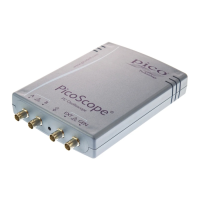Prog ramming the 3000A Series oscilloscopes118
Copyright © 2011-2013 Pico Technology Limited. All rights reserved.ps3000abpg.en r9
2.14.4
LabVIEW
The SDK contains a library of VIs that can be used to control the PicoScope 3000A and
some simple examples of using these VIs in streaming mode, block mode and rapid block
mode.
The LabVIEW library (PicoScope3000a.llb) can be placed in the user.lib sub-
directory to make the VIs available on the ‘User Libraries’ palette. You must also copy
ps3000a.dll and ps3000awrap.dll to the folder containing your LabVIEW
project.
The library contains the following VIs:
PicoErrorHandler.vi – takes an error cluster and, if an error has occurred,
displays a message box indicating the source of the error and the status code
returned by the driver
PicoScope3000aAdvancedTriggerSettings.vi – an interface for the
advanced trigger features of the oscilloscope
This VI is not required for setting up simple triggers, which are configured using
PicoScope3000aSettings.vi.
For further information on these trigger settings, see descriptions of the trigger
functions:
ps3000aSetTriggerChannelConditionsV2
ps3000aSetTriggerChannelDirectionsV2
ps3000aSetTriggerChannelProperties
ps3000aSetTriggerDigitalPortProperties
ps3000aSetPulseWidthQualifier
ps3000aSetTriggerDelay
PicoScope3000aAWG.vi – controls the arbitrary waveform generator
Standard waveforms or an arbitrary waveform can be selected under ‘Wave Type’.
There are three settings clusters: general settings that apply to both arbitrary and
standard waveforms, settings that apply only to standard waveforms and settings
that apply only to arbitrary waveforms. It is not necessary to connect all of these
clusters if only using arbitrary waveforms or only using standard waveforms.
When selecting an arbitrary waveform, it is necessary to specify a text file
containing the waveform. This text file should have a single value on each line in the
range -1 to 1. For further information on the settings, see descriptions of
ps3000aSetSigGenBuiltIn and ps3000aSetSigGenArbitrary.
PicoScope3000aClose.vi – closes the oscilloscope
Should be called before exiting an application.
PicoScope3000aGetBlock.vi – collects a block of data from the oscilloscope
This can be called in a loop in order to continually collect blocks of data. The
oscilloscope should first be set up by using PicoScope3000aSettings.vi. The
VI outputs data arrays in two clusters (max and min). If not using aggregation, ‘Min
Buffers’ is not used.

